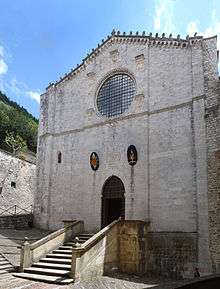Roman Catholic Diocese of Gubbio
| Diocese of Gubbio Dioecesis Eugubina | |
|---|---|
 Gubbio Cathedral | |
| Location | |
| Country |
|
| Ecclesiastical province | Perugia-Città della Pieve |
| Statistics | |
| Area | 900 km2 (350 sq mi) |
| Population - Total - Catholics |
(as of 2013) 55,754 52,181 (93.6%) |
| Parishes | 39 |
| Information | |
| Denomination | Catholic Church |
| Rite | Roman Rite |
| Established | 5th century |
| Cathedral | Cattedrale di Ss. Mariano e Giacomo Martiri |
| Secular priests |
35 (diocesan) 18 (religious Orders) |
| Current leadership | |
| Pope | Francis |
| Bishop | Mario Ceccobelli |
| Emeritus Bishops | Pietro Bottaccioli |
| Website | |
| www.webdiocesi.chiesacattolica.it | |
The Italian Catholic Diocese of Gubbio (Latin: Dioecesis Eugubina) is in the province of Perugia, in Umbria, central Italy.[1][2]
History
In the eighth century Gubbio became part of the Patrimony of St. Peter, together with the duchy of Spoleto. It was often at war with Perugia, and its victory in 1151 over Perugia and ten other towns is famous. St. Ubald, bishop of the city, directed the campaign. Gubbio favoured the Ghibelline party; however, in 1260 the Guelphs surprised the town, and drove out the Ghibellines; who returned again in 1300 under the leadership of Uguccione della Faggiola, and Federico I da Montefeltro, whereupon Pope Boniface VIII sent his nephew Napoleone Orsini who drove them out once more.
Giovanni Gabrielli, lord of Gubbio, was expelled by Cardinal Albornoz (1354) and the town handed over to a pontifical vicar. In 1381, however, the bishop, Gabriele Gabrielli, succeeded in being appointed pontifical vicar and again, lord of Gubbio.
The earliest known Bishop of Gubbio is Decentius, to whom Innocent I addressed (416) a letter concerning liturgy and church discipline.[3] Gregory the Great (590–604) entrusted to Bishop Gaudiosus of Gubbio the spiritual care of Tadinum, about a mile from the modern Gualdo, which had been long without a bishop of its own.
Arsenius of Gubbio (855) together with Nicholas of Anagni, opposed the election of Pope Benedict III. Other bishops of Gubbio were
- St. Rudolph Gabrielli (1061), honoured for his sanctity by Peter Damian;
- St. John of Lodi (1105), a monk of Fonte Avellana;
- St. Ubaldo (1160), in whose honour a church was built in 1197, which afterwards belonged to the Franciscans;
- Teobaldo, a monk of Fonte Avellana, against whom Emperor Frederick I Barbarossa set up as anti-bishop one Bonatto;
- St. Villano (1206);
- Fra Benvenuto (1278), papal legate to restore peace between Alfonso X of Castile and Philip III of France.
Cardinal Bembo and Marcello Cervino, afterwards Pope Marcellus II, were also bishops of Gubbio, likewise Alessandro Sperelli (1644), author of many learned works, who restored the cathedral. Gubbio was originally directly subject to the Holy See, but in 1563 became a suffragan of the Archdiocese of Urbino; as a result of the resistance begun by Bishop Mariano Savelli it was not until the eighteenth century that Urbino could exercise metropolitan jurisdiction.
Ordinaries
- St. Pietro Damiano, O.S.B. (1060–1066 Resigned)
- ...
- Gabriel Neccioli Gabriel (1377–1384 Died)
- ...
- Antonio Severini (1444–1472 Died)[4][5]
- ...
- Girolamo Basso Della Rovere (1482–1492 Resigned)
- ...
- Francesco Grosso della Rovere (1492–1504 Appointed, Bishop of Mende)
- Antonio Ferrero (1504–1508 Died)
- Federico Fregóso (1508–1541 Died)
- Pietro Bembo, O.S.Io.Hieros. (1541–1544 Appointed, Administrator of Bergamo)
- Marcello Cervini (1544–1555 Elected, Pope)
- Giacomo Savelli (cardinal) (1555–1556 Resigned)
- Mariano Savelli (1560–1599 Died)[6]
- Andrea Sorbolonghi (1600–1616 Died)[6]
- Alessandro Del Monte (1616–1628 Died)[6]
- Pietro Carpegna (1628–1630 Died)[6][7]
- Ulderico Carpegna (1630–1638 Appointed, Bishop of Todi)[6]
- Orazio Monaldi (1639–1643 Appointed, Bishop of Perugia)[6]
- Alessandro Sperelli, C.O. (1644–1672 Died)[6]
- Carlo Vincenzo Toti (1672–1690 Died)
- Sebastiano Pompilio Bonaventura (1690–1706 Appointed, Bishop of Corneto (Tarquinia) e Montefiascone)
- Fabio Mancinforte (1707–1725 Resigned)
- Sostegno Maria Cavalli, O.S.M. (1725–1747 Died)
- Giacomo Cingari (1747–1768 Died)
- Paolo Orefici (1768–1784 Died)
- Ottavio Angelelli (1785–1809 Died)
- Mario Ancaiani (1814–1821 Appointed, Archbishop of Spoleto)
- Vincenzo Massi (1821–1839 Resigned)
- Giuseppe Pecci (1841–1855 Died)
- Innocenzo Sannibale (1855–1891 Died)
- Luigi Lazzareschi (1891–1895 Resigned)
- Macario Sorini (1895–1900 Resigned)
- Angelo Maria Dolci (1900–1906 Appointed, Titular Archbishop of Nazianzus)
- Giovanni Battista Nasalli Rocca di Corneliano (1907–1916 Appointed, Secret Almoner of the Office of Papal Charities; appointed Cardinal in 1923)
- Carlo Taccetti (1917–1920 Died)
- Pio Leonardo Navarra, O.F.M. Conv. (1920–1932 Appointed, Bishop of Terracina, Priverno e Sezze)
- Beniamino Ubaldi (1932–1965 Died)
- Cesare Pagani (1972–1981 Appointed, Archbishop of Perugia)
- Ennio Antonelli (1982–1988 Appointed, Archbishop of Perugia-Città della Pieve)
- Pietro Bottaccioli (1989–2004 Retired)
- Mario Ceccobelli (2004–)
References
- ↑ "Diocese of Gubbio" Catholic-Hierarchy.org. David M. Cheney. Retrieved February 29, 2016
- ↑ "Diocese of Gubbio" GCatholic.org. Gabriel Chow. Retrieved February 29, 2016
- ↑ Jasper, Detlev (2001). Papal Letters in the Early Middle Ages. CUA Press. p. 227. ISBN 0813209196.
- ↑ Eubel, Konrad. HIERARCHIA CATHOLICA MEDII ET RECENTIORIS AEVI Vol II. p. 193.
- ↑ "Bishop Antonio Severini" Catholic-Hierarchy.org. David M. Cheney. Retrieved October 7, 2016
- 1 2 3 4 5 6 7 Gauchat, Patritius (Patrice). HIERARCHIA CATHOLICA MEDII ET RECENTIORIS AEVI Vol IV. pp. 183–184.
- ↑ "Bishop Pietro Carpegna" Catholic-Hierarchy.org. David M. Cheney. Retrieved December 13, 2016
Sources
- Cappelletti, Le chiese d'Italia (1846), V, 355-458;
- Sarti, De Episcopis Eugubinis (Pesaro, 1755);
- Lucarelli, Memorie e guida storica di Gubbio (Citta di Castello, 1886);
- Colasanti I, Gubbio in Italia Artistica (Bergamo, 1906), XIII.
![]()